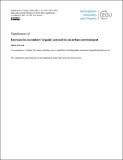Por favor, use este identificador para citar o enlazar a este item:
http://hdl.handle.net/10261/245115COMPARTIR / EXPORTAR:
 SHARE SHARE
 CORE
BASE CORE
BASE
|
|
| Visualizar otros formatos: MARC | Dublin Core | RDF | ORE | MODS | METS | DIDL | DATACITE | |

| Título: | Increase in secondary organic aerosol in an urban environment |
Autor: | Via, Marta CSIC ORCID; Minguillón, María Cruz CSIC ORCID ; Reche, Cristina CSIC ORCID; Querol, Xavier CSIC ORCID ; Alastuey, Andrés CSIC ORCID | Palabras clave: | Aerosols Urban air Urban environments Secondary organic aerosol |
Fecha de publicación: | 31-may-2021 | Editor: | European Geosciences Union | Citación: | Atmospheric Chemistry and Physics 21: 8323–8339 (2021) | Resumen: | The evolution of fine aerosol (PM1) species as well as the contribution of potential sources to the total organic aerosol (OA) at an urban background site in Barcelona, in the western Mediterranean basin (WMB) was investigated. For this purpose, a quadrupole aerosol chemical speciation monitor (Q-ACSM) was deployed to acquire real-time measurements for two 1-year periods: May 2014–May 2015 (period A) and September 2017–October 2018 (period B). Total PM1 concentrations showed a slight decrease (from 10.1 to 9.6 µg m−3 from A to B), although the relative contribution of inorganic and organic compounds varied significantly. Regarding inorganic compounds, SO2−4, black carbon (BC) and NH+4 showed a significant decrease from period A to B (−21 %, −18 % and −9 %, respectively), whilst NO−3 concentrations were higher in B (+8 %). Source apportionment revealed OA contained 46 % and 70 % secondary OA (SOA) in periods A and B, respectively. Two secondary oxygenated OA sources (OOA) were differentiated by their oxidation status (i.e. ageing): less oxidized (LO-OOA) and more oxidized (MO-OOA). Disregarding winter periods, when LO-OOA production was not favoured, LO-OOA transformation into MO-OOA was found to be more effective in period B. The lowest LO-OOA-to-MO-OOA ratio, excluding winter, was in September–October 2018 (0.65), implying an accumulation of aged OA after the high temperature and solar radiation conditions in the summer season. In addition to temperature, SOA (sum of OOA factors) was enhanced by exposure to NOx-polluted ambient and other pollutants, especially to O3 and during afternoon hours. The anthropogenic primary OA sources identified, cooking-related OA (COA), hydrocarbon-like OA (HOA), and biomass burning OA (BBOA), decreased from period A to B in both absolute concentrations and relative contribution (as a whole, 44 % and 30 %, respectively). However, their concentrations and proportion to OA grew rapidly during highly polluted episodes. The influence of certain atmospheric episodes on OA sources was also assessed. Both SOA factors were boosted with long- and medium-range circulations, especially those coming from inland Europe and the Mediterranean (triggering mainly MO-OOA) and summer breeze-driven regional circulation (mainly LO-OOA). In contrast, POA was enhanced either during air-renewal episodes or stagnation anticyclonic events. | Versión del editor: | https://doi.org/10.5194/acp-21-8323-2021 | URI: | http://hdl.handle.net/10261/245115 | DOI: | 10.5194/acp-21-8323-2021 |
| Aparece en las colecciones: | (IDAEA) Artículos |
Ficheros en este ítem:
| Fichero | Descripción | Tamaño | Formato | |
|---|---|---|---|---|
| acp-21-8323-2021.pdf | Artículo principal | 2,91 MB | Adobe PDF |  Visualizar/Abrir |
| acp-21-8323-2021-supplement.pdf | Material suplementario | 5,05 MB | Adobe PDF |  Visualizar/Abrir |
CORE Recommender
SCOPUSTM
Citations
24
checked on 09-abr-2024
WEB OF SCIENCETM
Citations
21
checked on 21-feb-2024
Page view(s)
71
checked on 23-abr-2024
Download(s)
76
checked on 23-abr-2024
Google ScholarTM
Check
Altmetric
Altmetric
NOTA: Los ítems de Digital.CSIC están protegidos por copyright, con todos los derechos reservados, a menos que se indique lo contrario.
